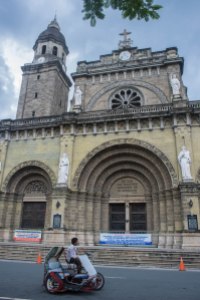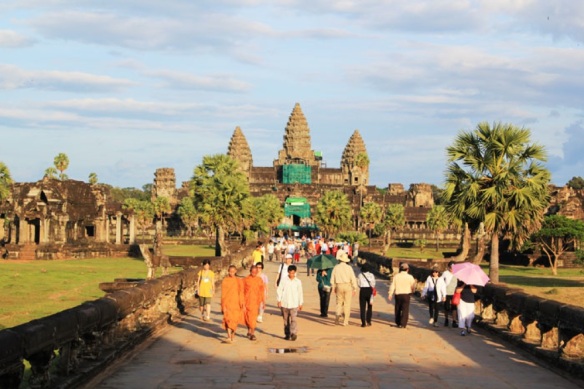The Philippines is looked over.
The visitor to the Philippines from the US is confronted with a large archipelago full of people who are very much aware of your homeland, who you yourself remain distinctly unaware of. All Californians grew up with Filipinos at school and in the neighborhood, but somehow we still looked through the reality of their place of origin.
Filipino restaurants didn’t dot the neighborhood, the local community college was unlikely to offer Tagalog lessons, and no one (other than Filipinos) spoke of saving up their money for that dream trip to Manila. Thailand and Vietnam seemed more real: even history books restricted the Philippines to a curious footnote in the remarkable career of MacArthur, or a paragraph or two about the Marcos regime, and Imelda’s fondness for footwear.
It is the overlooked Southeast Asian nation to the north, unless you’re a scuba diver: a long-term expat friend observed to me that he suspects the bulk of visitors are Hong Kong residents desperate to escape their peninsula for a long weekend. And there, Manila is only a brief plane ride away.
It is blighted perhaps but not all of it is blighted. In the rare event of seeing an image of Manila in the Western media, it is inevitable that a dump be portrayed. Perhaps a correspondent will be standing atop this remarkable monument to filth, looking concerned and talking about the Plight Of The Poor.
Manila’s not-so-poor warrant not a mention, and the decline of the corrupted but very interesting Marcoses has rendered even the elite unimportant. “There’s no there there,” one imagines Gertrude Stein observing of the place, circa 2013.
But Manila also possesses skyscrapers – great canyons of them, a skyline “that encircles you” as my friend observed — and universities with mowed grass, and an old Spanish center, and suburbs with single-family houses and a profusion of joggers. Also there are mallls, malls that would fit into Iowa City, with everyone nipping in for Taco Bell and the latest sale on Vons sneakers, and walking down long marbled corridors of entirely American-origin shops, with not a single hint that you are in fact in Asia.
A hefty percentage of the crowd is wearing a shirt with a NFL team logo on it, or the American flag, and even the children are outfitted in Adidas.
The entire city strikes me as some parallel American re-imagining in some ways. In some ways, it makes me feel embarrassed. We – nationally, in nationalist terms – did not do well by this country.
I decided to visit Intramuros because I am fond of Spanish colonial architecture, and also because I tend to feel that a good way to begin understanding what a city is all about is backtracking to where it first started from.
Manila was Intramuros and Intramuros was Manila before the slow progression of the city across the face of southern Luzon: here was the first Spanish feint into building their Ever Loyal City, populated by religious men, traders, and the local “Negritos” (as the locals, who were presumably both small and dark, were unkindly dubbed).
The sameness of the Spanish colonial experiment is remarkable to me, and it is also comforting, as someone who has spent a hefty percentage of my life residing within various bits of the former Iberian empire. The same cobblestone streets and high ceilings; the same growths of palm trees and yellow-washed walls, and courtyards with austere fountains in them, the same brown signs and road-side lanterns.
A stroll through Intramuros was very much akin to a stroll through the French Quarter (first built by the Spanish) or Ybor City in Tampa: I was disappointed to find that no one had thought to set up a shop producing hand-rolled cigars, though tobacco is not a primary Philippine export.
The San Agustin church in Intramuros was buit in 1589 and is one of the only structures still standing after the bombardment of the old city by WWII: it is an interesting mental exercise to stand here, and note that this church predates the oldest standing structures of the Spanish colonial experiment in New Mexico. The church itself is violently Iberian: a stone Roman Catholic edifice dotted with fading tapestries, chipped wooden sculptures of Christ and the disciples, and lightly-flickering candles. I was in Southeast Asia, but I was most reminded of my 2009 visit to Spanish Toledo: it was an entirely new form of exoticism.
San Agustin is also known as the wedding capital of the city, and for good reason: there was one going on the morning I was there. I spied upon the extremely long ceremony from behind a grate and from the balcony where the antique pipe organ sits: I never did manage to see The Kiss The Bride Part, and indeed, found it difficult to determine exactly when the ceremony ended. Thus is my knowledge of Catholic weddings.
I headed for lunch at the Ristorante Delle Mitre, acros the street from San Agustin. The restaurant is themed in a fashion that can only be described as “bishop,” with an extensive Philippine – Western menu where most of the dishes are named after either saints or former bishops.
Nuns in red and white habits circulate the place and man the kitchen, and the entire ambience is exactly that of a Cuban cafe in Tampa or in Miami. I ordered seafood chowder and an enormous pork knuckle in tomato sauce with plantains and was deeply satisfied. They brought me San Miguel in a frosted mug the size of my head, with lime in it. I did not try the cafe con leche: for a nation that grows excellent coffee, the coffee that is actually served in the Philippines is an exercise in disappointment.
I left the church and walked a block off Intramuros, the street beside the Manila House Museum, and you are back in the Phillipines: I walked down a Sunday street populated by people sitting about doing nothing in particular, as befits the Sabbath, listening to music and eating deep-fried bananas. “Hey girl!” a middle-aged man in a tank top said to me, waving from the corner.
I waved back. Waving back is a good idea here.


















